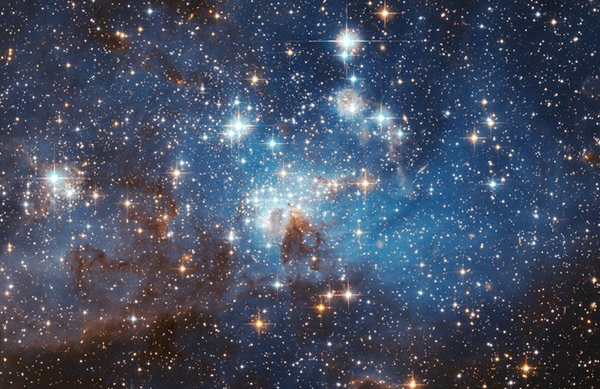What do you hear when you look into the night sky? If no one had ever seen a movie or television show about space, would we all imagine a different soundtrack in our minds?
If there was a way to translate the emotional experience of looking into the universe into a sonic one, we would probably all hear sounds unique to our own imaginations. And that’s just what composers have been doing for over 70 years. Like space itself, music is an evolution that is never-ending, as new technologies aim to heighten our aural connection with the universe.
A cosmic vocabulary
There is such wonderment as we gaze up at the known and unknown; translating that experience into sound is unique for each of us. However, composers have developed a vocabulary, if you will, of sounds that have been the soundtrack to planetarium shows, space apps, and all forms of media. The use of echo and reverb on notes that bend and softly merge into other sounds seems to transport us into a state that ignites our imagination. Space-themed music usually includes long non-rhythmic passages of sustained chords and suspended tempos, punctuated by subdued pulses and tonal melodies that crescendo and decrescendo.
One instrument in particular, called the theremin, has found its way into countless recordings and genres, with perhaps the most popular being on the song “Good Vibrations” by The Beach Boys. Created in 1919, the theremin electronically produces an eerie sound based on the movement of the player’s hands. While it has been incorporated into many symphonic compositions, Ferde Grofe first introduced the theremin into Hollywood’s outer space musical vocabulary in his 1950 score for Rocketship X-M. It was next used in 1951 by Bernard Herrmann in the science-fiction movie The Day The Earth Stood Still, and quickly became a signature sound identified with outer space.
Fast-forward to 2001, when a three-part interstellar radio transmission included music performed on a theremin, signaling to anyone out there that might be listening that this may be a representative sound for the cosmos. Many of us remember composer John Williams’ five-note motif in Close Encounters of the Third Kind, used to bridge the communication gap between aliens and humans; but who’s to say what musical choice might ultimately connect us?
Otherwordly techniques
The majority of music underscore for science fiction and space-related movies and television shows during the 1960s was recorded with traditional orchestral instruments in commercial recording studios. My love of space and music intersected after seeing the 1968 movie 2001: A Space Odyssey, where the use of classical music brought a never-before-heard dimension to the genre. And of course, Star Trek premiered in 1966 with its majestic and exciting theme song, which has become one of the most iconic in history. To this day, I still hear the four-note “ping” from its opening bars when I look at the stars.
As more composers experimented with orchestration techniques for the genre, they created more ambience and textures that gave their scores increased complexity. Examples of this are the use of the wooden side of a violin bow to vibrate the strings (a musical term called col legno), creating an airy percussive sound, or playing unnaturally near the violin bridge to bring out higher harmonics (called sul ponticello). While not as prevalent in space-themed movies and TV shows of the 1960s, later productions introduced unique percussion to create unfamiliar sounds. The strangeness of space calls on composers to seek instruments that produce unexpected sounds, and percussion instruments from around the world have been used as what composers like to refer to as “ear candy,” perking up the listener’s ear akin to tasting a new flavor for the first time.
One such sound, which has Tibetan roots and has been used in numerous shows, is called the waterphone. Its otherworldly sound is created by a bow vibrating different lengths of bronze rods connected to a bowl filled with water. Another similar sound is produced by the glass harmonica — an invention of Benjamin Franklin. It is that high-pitched ethereal, glassy sound you’ve often heard, which comes from applying friction to glass bowls or goblets.
1955 saw the birth of what has evolved into today’s musical synthesizer, which first entered popular music in the early 1960s. However, the ability to modify frequencies via oscillators created an entirely new landscape with unlimited timbres for film and TV composers. Used sparingly in movie scores during the 1960s, it wasn’t until the early 1970s that synthesizers started being used in space movies: Dark Star (1973) was probably the first to primarily use the technology.
As synthesizer technology improved, a new technique in the creation of original sounds emerged called sampling – whereby a recording is made of any sound and then electronically morphed so that it can be played (usually via a keyboard) like a new instrument. With ever-increasing sample fidelity, orchestral instruments could now augment electronic scores or even replace “live musicians,” giving composers much more flexibility to modify sounds to further enrich the viewer’s experience. Today, the use of synthesizers is ubiquitous and is usually a component in all the music we listen to, with many scores completely created from desktop computers via Digital Audio Workstations, or DAWs!
What the future holds for music of this genre is anyone’s guess, but as technology allows us to peer deeper into the cosmos, so too will new soundscapes seamlessly fuse our love of space and music.










